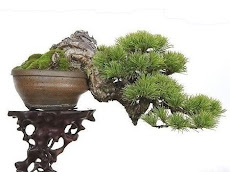By: Andrew Kozlowski
One of the most important elements of bonsai care is re-potting. Because a bonsai tree grows in a container, its root system, which grows right along with the plant, will eventually outgrow the pot. When this happens, the root system of the bonsai fills the container, the tree becomes “pot-bound,” and the feeder roots that absorb water and nutrients then have no room to grow.
To keep your bonsai healthy, you’ll need to re-pot with fresh soil. And while re-potting, you’ll have a chance to trim the root ball to allow it to become denser. A smaller but denser root ball is better for the tree because the emerging fine feeder roots act more efficiently than larger roots.
How do you know when it’s time to re-pot? You will know your tree is pot-bound if roots are circling the bottom of the pot or growing out of the drainage holes at the container’s base, and water is taking a long time to filter into the soil. Depending on the species, the size of the container, and the age of the tree, most bonsai need to be re-potted every two-to-five years. Faster growing and younger trees require re-potting more frequently than older bonsai.
The best time to re-pot most bonsai trees is at the end of the plant’s dormant period in the early spring. The re-potting process will stress the tree less at this time as it is only providing minimal nutrients to its leaves. Re-potting in early spring will also all the roots time to repair themselves by the time the tree starts growing again.
The following are tips on how to re-pot your bonsai:
Pick out a new container for your bonsai. It should be slightly larger than the original pot and of a shape and color that complement the growing tree.
Tilt your bonsai tree’s current pot to one side and tap the bottom to loosen the soil so you can lift out the plant. If it’s stuck, use a knife to cut away any caked soil. Do not tug on the plant!
Gently shake the tree to get rid of loose soil, and then using a root hook, root rake, knitting needles, or chopsticks, untangle the roots.
Using a sharp, clean pair of gardening scissors, trim the thickest, longest brown roots. (You can buy special bonsai root-pruning scissors.) Also remove any rotten or dried-out roots. Then trim the thinner roots that hang below the depth of the pot.
Cover the drainage holes of the new pot with a layer of plastic mesh attached with copper wire, and cover with a layer of grit or gravel for the best drainage.
Cover the gravel with a light base of nutrient-rich potting soil.
Place the tree near the center of the pot and fill the container with more soil, up to the base of the trunk. Pat the soil down so there are no air pockets between the roots.
Water gently but thoroughly, but do not add fertilizer for at least two weeks after re-potting because it can burn the roots. Make sure the re-potted tree is not exposed to direct sunlight or freezing temperatures.
About The Author
Andrew Kozlowski is a naturalist, amateur botanist, and author of articles and books on topics ranging from plant care and gardening to home downsizing. For more than 20 years Andrew has managed environmental programs in the U.S., Europe, Africa, and Latin America. He resides in San Francisco.
The author invites you to visit: http://www.bonsaitreeanswers.com
skip to main |
skip to sidebar
Guide and Tips on Bonsai growing and caring.Cultivation, pruning, shaping, an Art and Hobby for you to practice




No comments:
Post a Comment